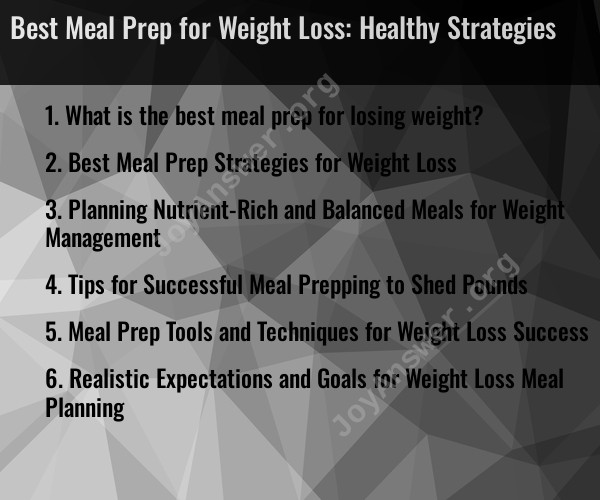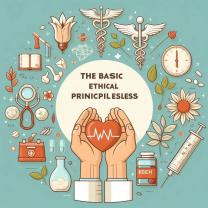What is the best meal prep for losing weight?
Effective meal prep for weight loss involves planning and preparing healthy, balanced meals in advance to help you stay on track with your nutrition goals. Here are some healthy strategies for the best meal prep for weight loss:
Set Clear Goals: Define your weight loss goals, including your target calorie intake and macronutrient ratios. This will guide your meal planning.
Choose Nutrient-Dense Foods: Focus on whole, nutrient-dense foods such as lean proteins, fruits, vegetables, whole grains, and healthy fats. These foods provide essential nutrients while keeping you full.
Portion Control: Use portion control to avoid overeating. Invest in portion-sized containers or measuring cups to help you accurately portion your meals.
Balanced Meals: Create balanced meals that include a source of lean protein, a variety of colorful vegetables, whole grains, and a small amount of healthy fats. This combination can keep you satisfied and provide essential nutrients.
Meal Frequency: Plan for regular, balanced meals throughout the day. Skipping meals can lead to overeating later on.
Snacks: Prepare healthy snacks like cut-up veggies, fruit, Greek yogurt, or nuts to curb hunger between meals.
Cook in Batches: Prepare multiple servings of a meal and store the extras for future use. This saves time and encourages healthy eating choices when you're busy.
Variety: Incorporate a variety of foods and flavors to prevent meal monotony. This can help you stick to your weight loss plan by making meals more enjoyable.
Prep Grains and Proteins: Cook grains (e.g., brown rice, quinoa) and proteins (e.g., chicken, tofu) in advance. They can be used as the base for different meals.
Pre-Cut and Wash: Wash and cut vegetables and fruits ahead of time. This makes it easier to add them to your meals.
Sauces and Dressings: Prepare healthy homemade sauces and dressings, or choose low-calorie options. Avoid high-calorie, sugary, or creamy sauces.
Label and Date: Label your meal containers with dates to keep track of freshness and avoid food waste.
Control Portions: Be mindful of portion sizes to avoid overeating. Use a kitchen scale or measuring cups to help with portion control.
Hydration: Stay hydrated by drinking water throughout the day. Sometimes thirst is mistaken for hunger.
Planning: Create a meal plan for the week, including breakfast, lunch, dinner, and snacks. Having a plan reduces the temptation to grab unhealthy options on the go.
Consistency: Stay consistent with your meal prep routine. It's more effective when done regularly.
Mindful Eating: Pay attention to what you eat and savor your meals. Mindful eating can help you avoid overeating and make healthier food choices.
Seek Support: Consider working with a registered dietitian or nutritionist who can tailor meal prep and nutritional guidance to your specific needs and goals.
Remember that weight loss is not only about meal prep but also about overall lifestyle choices, including regular physical activity and stress management. Consult with a healthcare professional or nutritionist for personalized advice and guidance on your weight loss journey.
Best Meal Prep Strategies for Weight Loss
Meal prepping can be a powerful tool for weight loss by providing you with healthy, portion-controlled meals throughout the week. Here are some effective strategies to incorporate meal prepping into your weight loss journey:
1. Plan and Schedule: Plan your meals for the week considering your calorie and macronutrient goals. Create a schedule that aligns with your lifestyle and cooking availability.
2. Cook in Bulk: Prepare larger batches of meals to save time and effort throughout the week. Portion out individual servings into containers for easy grab-and-go meals.
3. Incorporate Variety: Choose a variety of nutrient-rich ingredients from different food groups to ensure a balanced and satisfying diet. Include lean proteins, whole grains, fruits, and vegetables.
4. Prioritize Healthy Cooking Methods: Opt for healthier cooking methods like baking, grilling, roasting, or steaming to minimize added fats and calories.
5. Practice Portion Control: Use measuring cups and spoons to accurately portion out meals to avoid overeating and maintain your calorie goals.
Planning Nutrient-Rich and Balanced Meals for Weight Management
When planning your meals for weight loss, focus on incorporating nutrient-rich and balanced options that support your weight management goals:
1. Lean Proteins: Include lean protein sources like chicken, fish, beans, lentils, or tofu to promote satiety and support muscle mass.
2. Whole Grains: Choose whole grains over refined grains for their fiber content, which helps regulate blood sugar levels and promotes digestive health.
3. Fruits and Vegetables: Include a variety of fruits and vegetables in each meal to provide essential vitamins, minerals, and fiber. Aim for colorful produce options for a diverse nutrient intake.
4. Healthy Fats: Incorporate healthy fats from sources like avocados, nuts, seeds, and olive oil to support hormone regulation and nutrient absorption.
5. Limit Added Sugars and Processed Foods: Reduce consumption of added sugars, processed foods, and sugary drinks, as these contribute to weight gain and overall health issues.
Tips for Successful Meal Prepping to Shed Pounds
To make your meal prep sessions successful and sustainable, consider these helpful tips:
1. Set Realistic Goals: Start with manageable goals and gradually increase the complexity of your meal prep as you gain experience.
2. Utilize Convenient Tools: Invest in airtight food containers, reusable utensils, and a sharp knife to make the process more efficient and enjoyable.
3. Involve Others: Enlist the help of family or friends to make meal prep more fun and social. Share cooking tasks and encourage each other to stay on track.
4. Make it a Habit: Schedule regular times for meal prepping and stick to your schedule to establish a consistent routine.
5. Find Inspiration: Browse online resources, cookbooks, or food blogs for healthy and delicious meal prep recipes that suit your taste and dietary needs.
Meal Prep Tools and Techniques for Weight Loss Success
Utilize these meal prep tools and techniques to optimize your weight loss goals:
1. Slow Cooker: Utilize a slow cooker to prepare meals with minimal effort. Slow cooked meals are often rich in flavor and nutrients.
2. Food Processor: Use a food processor to quickly chop vegetables, shred fruits, and make healthy dips or sauces.
3. Salad Dressing Mixes: Prepare your own salad dressings with fresh herbs, spices, and vinegar for a healthier and tastier option than store-bought dressings.
4. Pre-Cooked Grains: Cook grains like quinoa, brown rice, or whole-wheat pasta in advance to save time and have them readily available for meals.
5. Reusable Grocery Bags: Use reusable grocery bags to carry your groceries and meal prep containers to reduce waste and promote eco-friendly practices.
Realistic Expectations and Goals for Weight Loss Meal Planning
Set realistic expectations and goals for your weight loss meal planning journey:
1. Gradual Progress: Aim for gradual and sustainable weight loss rather than drastic changes that may be difficult to maintain.
2. Individual Needs: Consider your individual needs, preferences, and lifestyle when planning your meals.
3. Consistency and Patience: Understand that weight loss takes time and effort. Stay consistent with your meal prep routine and be patient with the process.
4. Seek Professional Guidance: Consult a registered dietitian or nutritionist for personalized meal planning advice and support.
5. Enjoy the Process: Make meal prepping an enjoyable experience by experimenting with new recipes, trying different ingredients, and sharing meals with loved ones.












